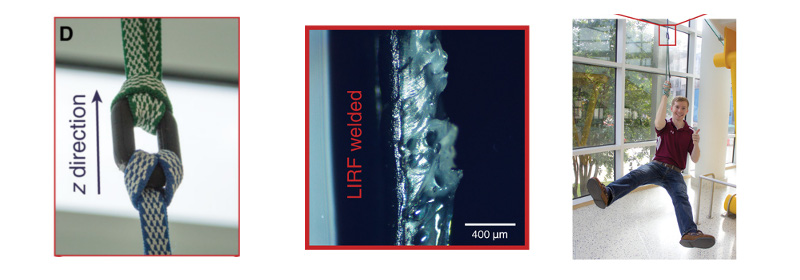3D printing has brought the production of plastic parts to the desktops and workshops of makers the world over, primarily through the use of FDM technology. The problem this method is that when squirting layers of hot plastic out to create a part, the subsequent vertical layers don’t adhere particularly well to each other, leading to poor strength and delamination problems. However, carbon nanotubes may hold some promise in solving this issue.
A useful property of carbon nanotubes is that they can be heated with microwave energy. Taking advantage of this, researchers coated PLA filament in a polymer film containing carbon nanotubes. As the layers of the print are laid down, the nanotubes are primarily located at the interface between the vertical layers. By using microwaves to heat the nanotubes, this allows the print to be locally heated at the interface between layers, essentially welding the layers together. As far as results are concerned, the team reports an impressive 275% improvement in fracture strength over traditionally printed parts.
The research paper is freely available, which we always like to see. There’s other methods to improve your print strength, too – you could always try annealing your printed parts.
[Thanks ????[d] ???? for the tip]















This appears at first sight borderline too good to be true for printed parts.
On the other hand we will (Should) be seeing more structurally challenging lighter weight 3d printed machinery.
i.e. minimalist full polymer bicycles, bearings, levers, the whole thing. Maybe even a hard road tire printed to boot.
It is just the beginning, I expect cross-linking of the polymer with functionalized nanotubes next. Then electroplating or other forms of deposition for hardening the working surfaces of the parts.
Carbon nanotubes seems to be a big hazard help, especially for the lungs. Like the asbestos fibers, they can easily enter the lungs, but are to small for our immune system to fight with them.
Well there is already this advice, https://www.cdc.gov/niosh/docs/2013-145/ if you need to work with them.
No, they easily damage the lungs, the fibers are rather stiff and razor sharp (like asbestos). Most fine stuff will enter the lungs easiky, vut nit all of it is as hazardous. That being said, sharp fiberlike stuff is generally a bad thing in your lungs. If the tubes are just produced (and not entangled) they pose the highest risk. They do burn, so its not as bad as wirh asbestos. Grinding the stuff could be an issue though
Another very easy & strong way to increase the strength of 3D printed parts is to print some strategically placed holes into the part and after printing fill those holes with bolts and put some nuts at the end.
You don’t neccacerilly have to use the bolts to bolt different parts together. You can also use them to strengthen a single part.
A single M3 bolt of 12.9 quality can hold 5.3kN (500Kg, 1000lbs (“pounds” or whatever those imperialists call it)).
How many stones is that? :P
Depends on what planet you live on and of the size and material of the stones.
Over here in Europe some guy a long time ago had an idea to:
comprise a coherent system of units of measurement built on seven base units.
We call it SI:
https://en.wikipedia.org/wiki/International_System_of_Units
Also over in Europe, a long time ago, some guy had the idea for Imperial Units.
A stone is actually another imperial unit for weight, in case you didn’t know. And it’s probably defined by SI by now, just like all the other imperial units.
The technology looks promising.
So what does a kg of those nanotubes cost, where can I get then or when are they projected to be somewhat affordable.
The video they made is extremely annoying. Don’t watch it, I warned you.
And they have claimed to have patened the technology to heat the nanotubes.
… Which will likely result in a 10 to 20 year delay in widespread application.
For example TORX screws were patented in 1969, patents expired in the early ’90-s and it’s still struggling to gain wide accpetance.
Only a few years ago a new local hardware chain (Hornbach) opened it’s doors in this town and I was pleasantly surprised that they defaulted to TORX for a large part of their screws collection.
No more Philips / Pozidrive !
https://www.google.com/patents/US3584667
https://en.wikipedia.org/wiki/Torx
Probably struggling because Phillips drywall screws are the “duct tape” for the DIYer. Main place I see TORX used is in deck screws.
In Canada we use Robertson for decks and more.
I wonder if a 2-color printer could print capacitors.. a nano-color and a poly?